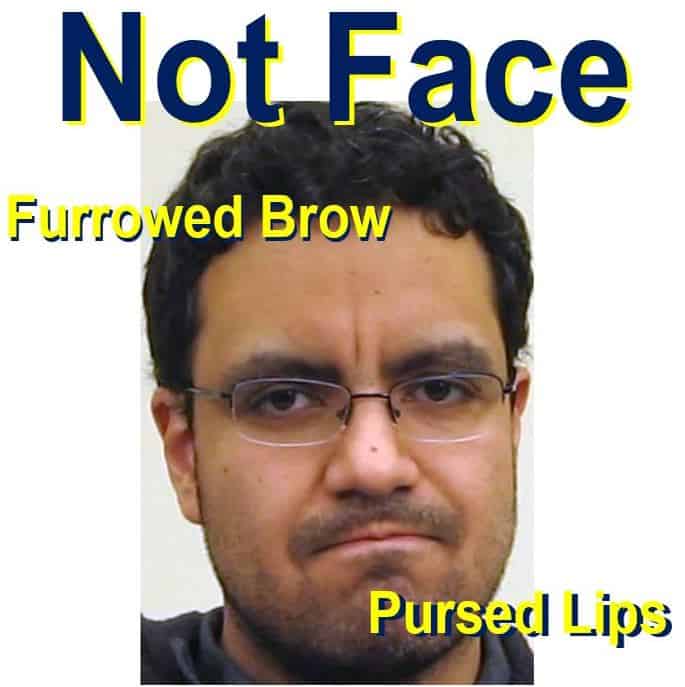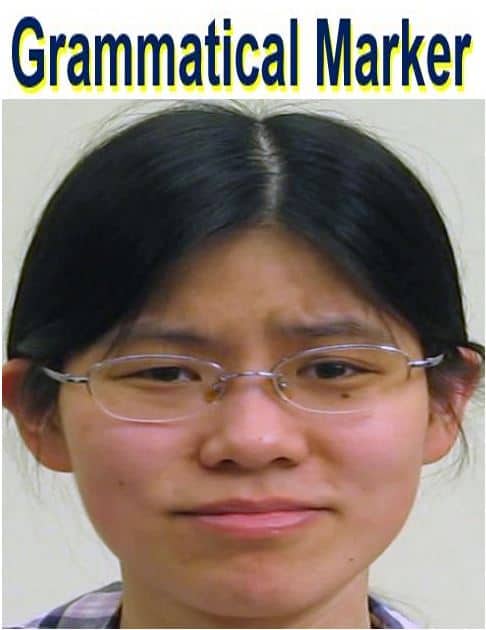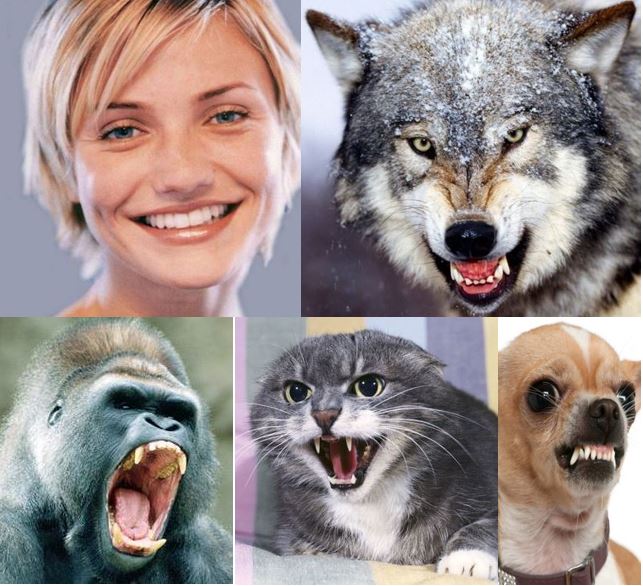There is a universal facial expression that speakers of many languages across the world use to express a negative emotion – it is called the Not Face. This body language expression, which has been classed as a grammatical marker, is recognized and used by virtually everybody when conveying negative sentiments.
Body language, or kinesic communication, refers to how we communicate non-verbally using our bodies.
Researchers from The Ohio State University and Purdue University wrote in the academic journal Cognition (citation below) that the Not Face is used by native speakers of Mandarin Chinese, Spanish, English and American Sign Language (ASL), and probably several others.
The expression consists of a raised chin, pressed lips and a furrowed brow. Because humans make it when they express negative sentiments, such as ‘I do not agree’, contempt or disgust, the team has dubbed it the Not Face.
 Here, a student participating in the study makes the facial expression, which the researchers have dubbed the ‘Not Face’. (Image: courtesy of The Ohio State University)
Here, a student participating in the study makes the facial expression, which the researchers have dubbed the ‘Not Face’. (Image: courtesy of The Ohio State University)
American Sign Language speakers often make the Not Face instead of using the sign word ‘not’ – an ASL facial expression that had not been documented before, the authors wrote.
Aleix M. Martinez, a Professor at The Ohio State University’s Department of Electrical and Computer Engineering, and founder/director of the Computational Biology and Cognitive Science Lab, said:
“To our knowledge, this is the first evidence that the facial expressions we use to communicate negative moral judgment have been compounded into a unique, universal part of language.”
“Where did language come from? This is a question that the scientific community has grappled with for a very long time,” he continued. “This study strongly suggests a link between language and facial expressions of emotion.”
Face to express moral disagreement, disgust and contempt
In this study, the researchers had hypothesized that if a universal Not Face really did exist, it would probably include the three basic facial expressions that we all accept as indicating contempt, disgust and moral disagreement.
 The ‘Not Face’ is a facial grammatical marker – a facial expression that determines the grammatical function of a sentence. (Image: courtesy of The Ohio State University)
The ‘Not Face’ is a facial grammatical marker – a facial expression that determines the grammatical function of a sentence. (Image: courtesy of The Ohio State University)
Prof. Martinez and colleagues had previously used computer algorithms to identify twenty-one different emotional expression – including complex ones that are combinations of more basic emotions.
‘Disgusted’ and ‘Happy’, for example, can be combined to produce ‘happily disgusted’, a facial expression that humans might make when see adorable baby poops in a nappy (US: diaper) or are watching a gross-out comedy.
Communicating anger or aggression has survival benefits
So why focus on expressions for negative sentiments? Charles Darwin (1809-1882), the British naturalist and geologist, best known for his contributions to evolutionary theory, believed that our ability to communicate aggression or anger was key to human survival long before we started developing the ability to talk, said Prof. Martinez.
Therefore, the team suspected that if there really was a universal facial expression for an emotion, one for disagreement or disapproval would likely be the easiest to identify.
The researchers carried out a test to see whether their hypothesis was correct. They sat 158 volunteers, all of them Ohio State students, in front of a digital camera.
The test-participants had a casual conversation with a person behind the camera in their native language, during which they were filmed and photographed.
 In this study, the ‘Not Face’ was used by native speakers of English, Spanish and Mandarin, as well as users of American Sign Language. It is probably a universal facial expression, i.e. used in virtually all languages and cultures. (Image: courtesy of The Ohio State University)
In this study, the ‘Not Face’ was used by native speakers of English, Spanish and Mandarin, as well as users of American Sign Language. It is probably a universal facial expression, i.e. used in virtually all languages and cultures. (Image: courtesy of The Ohio State University)
The volunteers belonged to four groups, which were selected to represent a wide range of grammatical structures. Spanish is a Latin-based language, English is Germanic, Mandarin Chinese is modern form of Middle Chinese that was formalized early in the last century. American Sign Language, like other forms of sign language, combines body, head and hand movements and gestures, as well as facial expressions to communicate phrases or individual words.
Facial grammatical marker
Prof. Martinez and colleagues were looking for a facial ‘grammatical marker’ – a facial expression that determines the grammatical function of a phrase or sentence. For example, in the sentence ‘I am not going to the meeting,’ the word ‘not’ is a grammatical marker of negation. Without it, the meaning of the sentence would change completely (it would mean the opposite).
If there is a universal grammatical marker of negation, the team reasoned, then all the test volunteers would make similar facial expressions when using that grammatical marker, no matter which language they were speaking or signing.
 The ‘Not Face’ is commonly used by the world’s politicians. While searching for a suitable image of Barack Obama, I noticed that he hardly ever has a furrowed brow.
The ‘Not Face’ is commonly used by the world’s politicians. While searching for a suitable image of Barack Obama, I noticed that he hardly ever has a furrowed brow.
They should all make the same Not Face together with – or instead of – the signed or spoken marker of negation.
The tests went as follows: The participants either recited or memorized negative sentence that the investigators had written for them ahead of time, or they were prompted with questions that were likely to illicit disagreement. For example, the volunteer might hear ‘A study shows that tuition should increase 30%. What do you think?” – not an idea that students are likely to agree with.
In all the four groups – ASL, Mandarin, Spanish and English – Prof. Martinez and colleagues identified clear grammatical markers of negations. The volunteers’ answers translated to statements such as ‘They should not do that,’ or ‘That’s not a good idea.’
The investigators manually tagged images of the participants speaking, frame by frame, to show which facial muscles were moving and how (which directions). Then computer algorithms searched the thousands of resulting finds to pick out commonalities among them.
 Are we the only animals that deliberately display our teeth to convey sentiments of happiness, friendship and love?
Are we the only animals that deliberately display our teeth to convey sentiments of happiness, friendship and love?
And the Not Face surfaced
A Not Face emerged – the pressed-together lips of ‘contempt’, combined with the furrowed brows of ‘anger’ and the raised chin of ‘disgust’.
The same three facial muscle movements were evident, regardless of which language participants’ spoke or signed, when they communicated negative sentences.
Computer analysis also compared the tempo at which participants’ facial muscles moved.
Typical human speech varies between 3 to 8 syllables per second, i.e. 3 to 8 Hz (hertz), a measure of frequency. The authors believe that the human brain is wired to recognize grammatical constructs that fall between 3 and 8 Hz as language.
Prof. Martinez and his team reasoned that if all participants’ facial muscles moved to make the Non Face within the 3 to 8 Hz band, then the face itself probably functions as a universal grammatical marker of language.
The tempo of the Not Face was not identical in all languages:
– Native English: 4.33 Hz
– Native Spanish: 5.23 Hz
– Mandarin Chinese: 7.49 Hz
– ASL: 5.48 Hz
However, in all four groups, the frequencies were within the 3-to-8 Hz range of spoken communication, which suggests that the facial expression really is a grammatical marker, the authors wrote.
ASL students used Not Face to replace words
Something quite unique emerged in the studies with the ASL-signing participants. They used the facial expression differently from the others – as if it were the unique grammatical marker in the signed sentence.
People sometimes either signed the word ‘not’, or just shook their head ‘no’ when they got to the part of the phrase where they would have signed ‘not’. Both are accepted ASL ways to communicate negation.
However, sometimes speakers neither made the sign for ‘not’ nor shook their ‘head’ – they simply made the Not Face, as if the facial expression itself was explicit enough to be the marker of negation in the sentence.
This is the first time that users of sign language have been observed saying ‘not’ just by making the face.
Prof. Martinez said:
“This facial expression not only exists, but in some instances, it is the only marker of negation in a signed sentence. Sometimes the only way you can tell that the meaning of the sentence is negative is that person made the ‘not face’ when they signed it.”
Prof. Martinez said manual analysis of the facial expressions was painstaking. Now that the team have demonstrated that the experiment works, they hope to make the next phase of the project completely automatic, with new algorithms that will extract and analyze facial movements without human intervention. They are currently building those algorithms.
Once they have finished, they will take a ‘big data’ approach to explore even deeper into the origins of language. They will first analyze 1,000 hours of YouTube video people talking – the equivalent of about 100 million still frames. They want to eventually amass 10,000 hours of data, or one billion frames.
They would also like to identify the facial expressions that go along with other grammatical markers, such as positive ones.
Prof. Martinez believes the whole thing will take decades to complete. “Most expressions don’t stand out as much as the Not Face,” he explained.
This study was supported by the US National Institutes of Health.
Citation
“The not face: A grammaticalization of facial expressions of emotion,” C. Fabian Benitez-Quiroza, Ronnie B. Wilburb, Aleix M. Martinez. Cognition Volume 150, Pages 77-84. May 2016. DOI: 10.1016/j.cognition.2016.02.004.
